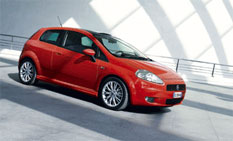Review
On stage, in front of more than 1,300 journalists attending the launch of the Grande Punto, his Italian gushes forth, every word sizzling with enthusiasm.
And although his awe-inspiring performance loses some of its zest when filtered through the patchy translation of an elderly woman from Derby, the general message gets through.
Basically, the new Punto is Grande in more ways than one. Yes it is bigger, more spacious and has a mind-boggling array of potential specifications for customers seeking that little individual touch, but it is also at the heart of the revival of the brand.
Fresh from its less-than-amicable split with General Motors, the new Punto carries the weight of Fiat’s future on its small shoulders.
The chairman’s words are echoed over the next couple of days in endless briefings as Fiat hammers home its enthusiasm for the car.
This new car will relaunch Fiat, according to the mayor of Turin, Fiat’s home town, it is the ‘comeback of a record holder’, according to Luca de Meo, the brand director.
With sales expected to reach 360,000 a year, it will account for more than 40% of Fiat’s annual sales and add to a driver base of more than six million using previous generation Puntos.
The new model is expected to win over one million new customers to the brand and be the main pillar of Fiat’s commercial growth.
Half of annual sales will be in Italy, with the UK accounting for about 22,500 sales – or 45% of Fiat UK’s planned sales volume.
The new Grande Punto sports a smart new face and, according to numerous Fiat executives, looks a lot like a small Maserati.
At more than four metres long, the model is more than 20cm longer than the outgoing model, which will remain on sale in limited variants, offering a cheap first step on the Punto ladder.
It will be offered with a choice of six engines, with four diesels – two 1.3-litre Multijets, offering 75bhp and 90bhp, along with two 1.9-litre units pushing out 120bhp and 130bhp – and two petrol engines: a 65bhp 1.2-litre and a new 1.4-litre with 77bhp.
Other more powerful models will follow, including a 150bhp diesel and a turbo petrol offering 180bhp. An Abarth version, previewed last week in Fleet News, will also join the range later with 200bhp a real possibility.
The petrol engines get a five-speed manual gearbox and a separate five-speed unit for the 75bhp diesel. A six-speed gearbox is fitted to the other diesels. Automatic gearboxes will follow some time in 2006.
Specification and prices have yet to be decided for the UK market, but familiar names such as Active, Dynamic and Eleganza are likely.
Fiat’s efforts to offer as much choice as customers can stomach means there are 35 interior combinations, which combined with 13 body colours, two bodystyles (three or five-door) the gearboxes and engine options means there are 100,000 potential specifications.
A now traditional array of safety equipment to stop the car from skidding in all circumstances, intelligent airbags that react to different types of crashes, curtain, side and (optional) knee airbags and a stronger body, mean a five-star NCAP rating is already in the bag, but there is also plenty to entice drivers not planning on smashing their new car into someone else.
Noise levels have been significantly reduced and the seats have been developed to improve comfort.
On board, equipment offered will include a hill-holder option that keeps the brakes on for a split second for hill starts with no roll-back. Electric power steering with a ‘City’ function remains, offering fingertip turning for parking, while there is also a range of sound systems, Bluetooth functionality and even voice recognition and dual-zone air-conditioning will be available.
Other items on the choice list includes cruise control, parking sensors, rain-sensing wipers, tyre pressure sensors and a panoramic sunroof.
Fiat also promises that quality will come as standard with this model, ranging from the materials used to how they perform in the long-term. Even the dealership experience will be vastly improved.
Fiat’s UK managing director Giulio Salomone, said: ‘We start preparing now, following the restructuring we have had, so that we are ready to go into 2006 to invest in the launch of the new model.
‘Over the next year, three new products will be supporting us to reach sales of 50,000 and they will be the Panda, Croma and new Grande Punto, helped by our entire range, from Stilo to Multipla and Doblo.
‘It is a new era that started with the Panda. And we are not just a value-for-money brand. As we have shown, we also make beautiful cars.’

Behind the wheel
JUST in case the hordes of journalists were in any doubt about the importance of the Grande Punto, Fiat wheeled out Ferrari F1 star Michael Schumacher to hammer home the point.
And he revealed he would happily give up a world championship win to see the Grande Punto become a success.
The sporting links don’t end there, with the suggestion that the new Punto looks like a little Maserati – which indeed it does. Quite how Maserati owners will feel about this direct link to a mass market supermini is anyone’s guess.
From the rear, the Punto returns to being a humble hatchback, complete with a tailgate that can only be opened using a key fob or a button inside the car – a design that is bound to frustrate many drivers.
The seats are comfortable and the switchgear feels solid, although there are lots of hard plastics and the central console feels fragile.
The power steering is wonderfully light at parking speeds if you use the City button and weights up nicely at speed, although for press-on driving it doesn’t inspire by letting you know the limits of grip.
Of the available engines, the diesels are clearly the most economical, with the 75bhp 1.3 offering 60mpg, while the 90bhp offers 61mpg.
The six-speed gearbox in the higher power version was smooth compared to the baulky five-speed in the 75bhp model. Both engines slowly gathered revs, rather than racing to the red line, but at cruising speed both were quiet.
However, the 1.4 petrol achieves 46mpg and offers 145g/km (the same as the 1.2), so when it is launched it will attract 16% company car tax, compared to the two diesels which incur a 3% penalty and therefore will be charged at 18%.
The petrol is also quieter at idle and quicker to gain revs, while its five-speed gearbox felt less obstructive than the unit in the diesel version.
Furthermore, these cars are unlikely to cover high mileages so the fuel savings are minimal. Fleet decision-makers will need to do their sums before committing to a certain model.
Driving verdict
Fiat has high hopes for the Grande Punto and it certainly has a lot going for it, especially its looks. If Fiat’s promise of better build quality and high customer service levels comes true, then it is definitely worth considering.

Fiat Grande fact file
| Model: | 1.2 | 1.4 | 1.3 MJet 75 | 1.3 MJet 90 | 1.9 MJet 120 | 1.9 MJet 130 | ||||||
| Max power (bhp/rpm): | 65/5,500 | 77/6,000 | 75/4,000 | 90/4,000 | 120/4,000 | 130/4,000 | ||||||
| Max torque (lb-ft/rpm): | 75/3,000 | 85/3,000 | 140/1,750 | 148/1,750 | 206/2,000 | 206/2,000 | ||||||
| Max speed (mph): | 96 | 103 | 103 | 109 | 118 | 124 | ||||||
| 0-62mph (sec): | 14.5 | 13.2 | 13.6 | 11.9 | 10 | 9.5 | ||||||
| Fuel consumption (mpg): | 46 | 46 | 60 | 61 | 50 | 49 | ||||||
| CO2 emissions (g/km): | 145 | 145 | 123 | 122 | 149 | 150 | ||||||
| On sale: | February 2006 | Prices: | TBA | |||||||||

















